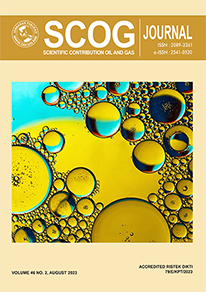The Comparation of Water Saturation Approaches to Reveal a Low Resistivity Reservoir Potential Case in Gumai Formation, South Sumatra Basin
DOI:
https://doi.org/10.29017/SCOG.46.2.1563Keywords:
petrophysics, LRLC, CEC, and gumai formationAbstract
The LRLC reservoir zone has been identified in SN-3 well, at the DAP-1 interval on Gumai Formation. This interval has a low resistivity value from 3-5 ohm.m and the drill stem test (DST) results show oil with gas without water. This study is objected to identify the causes of LRLC reservoir in gumai formation and finding a suitable sw calculation method. Some data such as well logs, reports, cores, and XRD are used to calculate petrophysical parameters such as Vsh, Phie, and Sw, and would be validated by DST data. Water saturation (Sw) calculations from Archie and the CEC method (Waxman Smits, Dual Water, Juhasz) were performed and the results were compared. The results showed that the main cause of the DAP-1 interval LRLC zone was the presence of clay minerals consisting of mixed layers (Illite/smectite). These clay minerals will be associated with high cation exchange capacity (CEC) values, with the value 70 (meq/100g), which can increase conductivity and reduce resistivity values. Based on lumping the more optimistic results of sw calculation from Waxman Smits Sw method (Sw based on CEC method). The DST data on the SN-3 well does not have water test data, so the calculation of the Sw value that is close to the Swirr value is considered the most suitable Sw for the low resistivity reservoir conditions of the Gumai Formation in the study area. The best practice for low resistivity reservoir for suitable petrophysical calculation is necessary to pay attention to the rock lithology conditions, the presence of mineral clay, and determining suitable Sw appropriate to the reservoir conditionsReferences
Audinno, R.T., Pratama, I.P., Halim, A., and Kusuma, D.P. (2016) Integrated Analysis of The-Low Resistivity Hydrocarbon Reservoir in the “S†Field, in Proceedings Indonesian Petroleum Association (IPA), 40th Annual
Convention & Exhibition, p.
Badan Informasi Geospasial (2019) Peta RBI: Peta Rupa Bumi Indonesia. https://tanahair.indonesia.go.id/portalweb/download/perwilayah.
Barber, A.J., Crow, M. J. and Milsom, J.S. (2005) Sumatra: Geology, Resources and Tectonic Evolution, Geology Society Memoir, London, No. 31.
Bishop, M.G. (2001) South Sumatra Basin Province, Indonesia: The Lahat/Talangakar- Cenozoic Total Petroleum System, USGS, Wyoming Colorado, 90-50-S, p. 1-19.
Boyd, A., Darling, H., Tabanou, J., Davis, B., Lyon, B., Flaum, C., Klien, J., Sneider, R.M., Sibbit, A., Singer, J. (1995) The Lowdown on Low- Resistivity Pay, in Oil field Review, Schlumberger, p. 4-18.
Dwiyono, I.F., and Winardi, S. (2014) Kompilasi Metode Water Saturation Dalam Evaluasi Formasi, In Proceeding Seminar Nasional Kebumian Ke-7, p. 420-437.
Faiza, I. W., Irawan, D., Rakha, M., F, M, A. (2019) Integrated Initial Water Saturation Modelling, in Scientific Contributions Oil and Gas (SCOG) Vol.42, p. 95-107.
Ginger, D., and Fielding, K. (2005) The Petroleum System and Future Potential of The South Sumatra Basin, in Proceedings. Indonesian Petroleum Association (IPA) 30th Annual Convention & Exhibition, p -.
Hamada, G.M., Al-Awad, M.N.J. (2000) Petrophysical Evaluation of Low Resistivity Sandstone Reservoir, in Journal of Canadian Petroleum Technology Vol.9, p. 7- 14.
Holis, Z., Prayogi, A., Puurwaman, I., Damayanti, S., Nugroho, D., Kamaludin, M.K. (2016) The Petrophysic Role of Low Resistivity Pay Zone of Talang Akar Formation, South Sumatra Basin, Indonesia, in SPE Asia Pacific Oil and Gas Conference & Exhibition All Dayas, Perth, Australia, SPE-18244, p. 2-20.
Melfi, F., Setyowiyoto, J., and Wintolo, D. (2017), Evaluasi Petrofisika Low- Resistivity Pada Potensi Reservoar Hidrokarbon Formasi Gumai Cekungan Sumatra Selatan, in Proceeding Seminar Nasional Kebumian Ke-10, p 590-599.
Palacky, G. (1987) Resistivity Characteristics of Geological Targets, in Nabighian, Electromagnetic Methods in Applied Geophysics- Theory, Society of Exploration Geophysicists, Tulsa, p. 53-129.
Pulunggono, A., Haryo, A.S., Kosuma, C.G. (1992) Pre-Tertiary and Tertiary Fault System as a Framework of the South Sumatera Basin: A Study of Sar-Maps, in Proceedings. Indonesian Petroleum Association, 21th Annual Convention & Exhibition, p.
Rohmana, R.C., Setyowiyoto, J., Husein, S., Indra, Y., and Ramadhan, A. (2017) Evaluasi dan Perbandingan Reservoar Low-Resistivity Formasi Cibulakan Atas, Cekungan Jawa Barat Dengan Formasi Gumai, Sub-Cekungan Jambi, in Proceedings Seminar Nasional Kebumian Ke-10, Indonesia, p. 573-589.
Sarjono, S., dan Sardjito. (1989) Hydrocarbon Source Rock Identification In The South Palembang Sub-Basin, in Proceedings. Indonesian Petroleum Association, 18th Annual & Exhibition, p. 427–467.
Tribuana, I. Y., Yogi, A., Prabowo., Wibowo, A, S., Sudija P., Durahman, Y. (2015) Optimization Of Measurement Speed For Spectral Gamma Ray and Clay Mineral Identification, in Scientific Contributions Oil and Gas (SCOG) Vol.38, p. 181-191.
Worthingthon, P.F. (1997) Recognition and Development of Low-Resistivity Pay. SPE Asia Pacific Oil and Gas Conference and Exhibition. SPE-38035-MS.
Worthington, P.F. (2000) Recognition and Evaluation of Low-Resistivity Pay, Petroleum Geoscience, Vol. 6, p. 77–92.
Zaemi, F.F., Rohmana, C.R., and Atmoko, W. (2022) Uncovering The Potential of Low Resistivity Reservoirs Through Integrated Analysis : A Case Study from The Talang Akar Formation in The South Sumatra Basin, in Scientific Contributions Oil and Gas (SCOG) Vol.45, p. 169-181.
Downloads
Published
Issue
Section
License
Copyright (c) 2023 © Copyright by Authors. Published by LEMIGAS

This work is licensed under a Creative Commons Attribution 4.0 International License.
Authors are free to Share — copy and redistribute the material in any medium or format for any purpose, even commercially Adapt — remix, transform, and build upon the material for any purpose, even commercially.
The licensor cannot revoke these freedoms as long as you follow the license terms, under the following terms Attribution — You must give appropriate credit , provide a link to the license, and indicate if changes were made . You may do so in any reasonable manner, but not in any way that suggests the licensor endorses you or your use.
No additional restrictions — You may not apply legal terms or technological measures that legally restrict others from doing anything the license permits.














